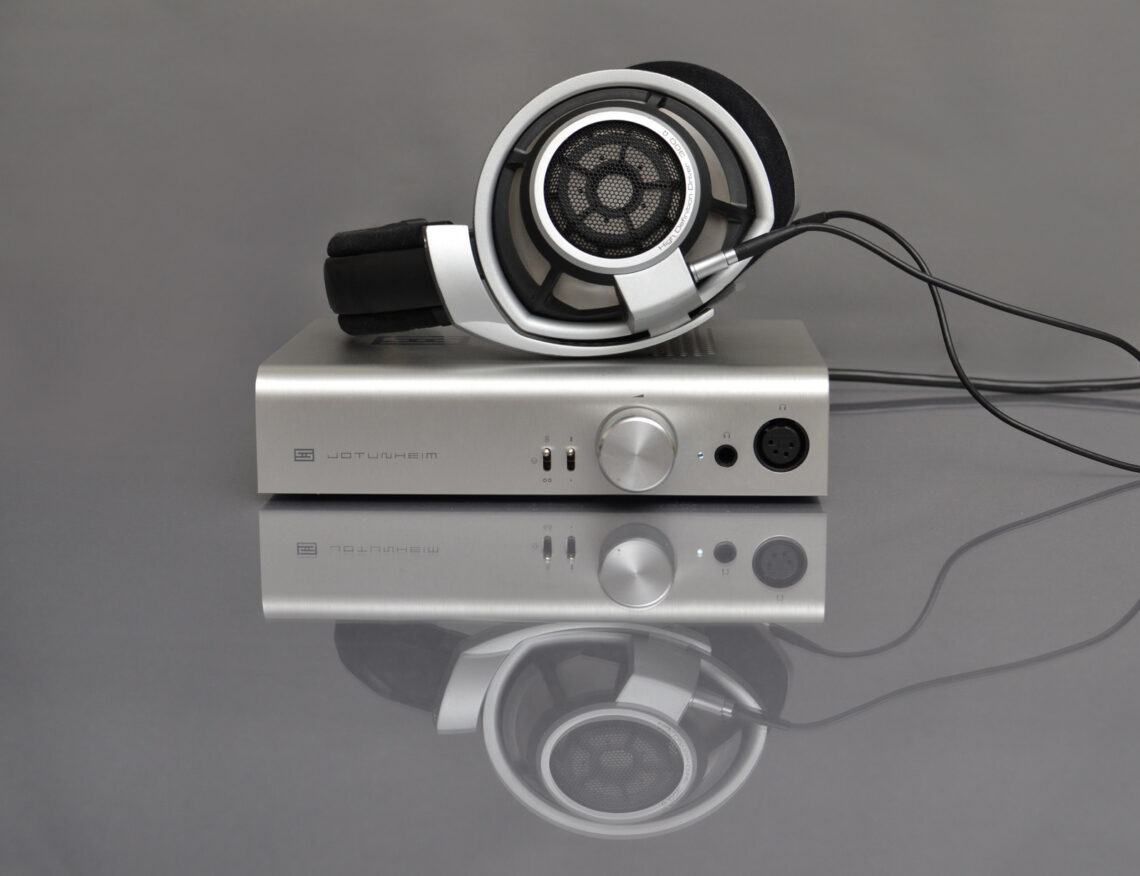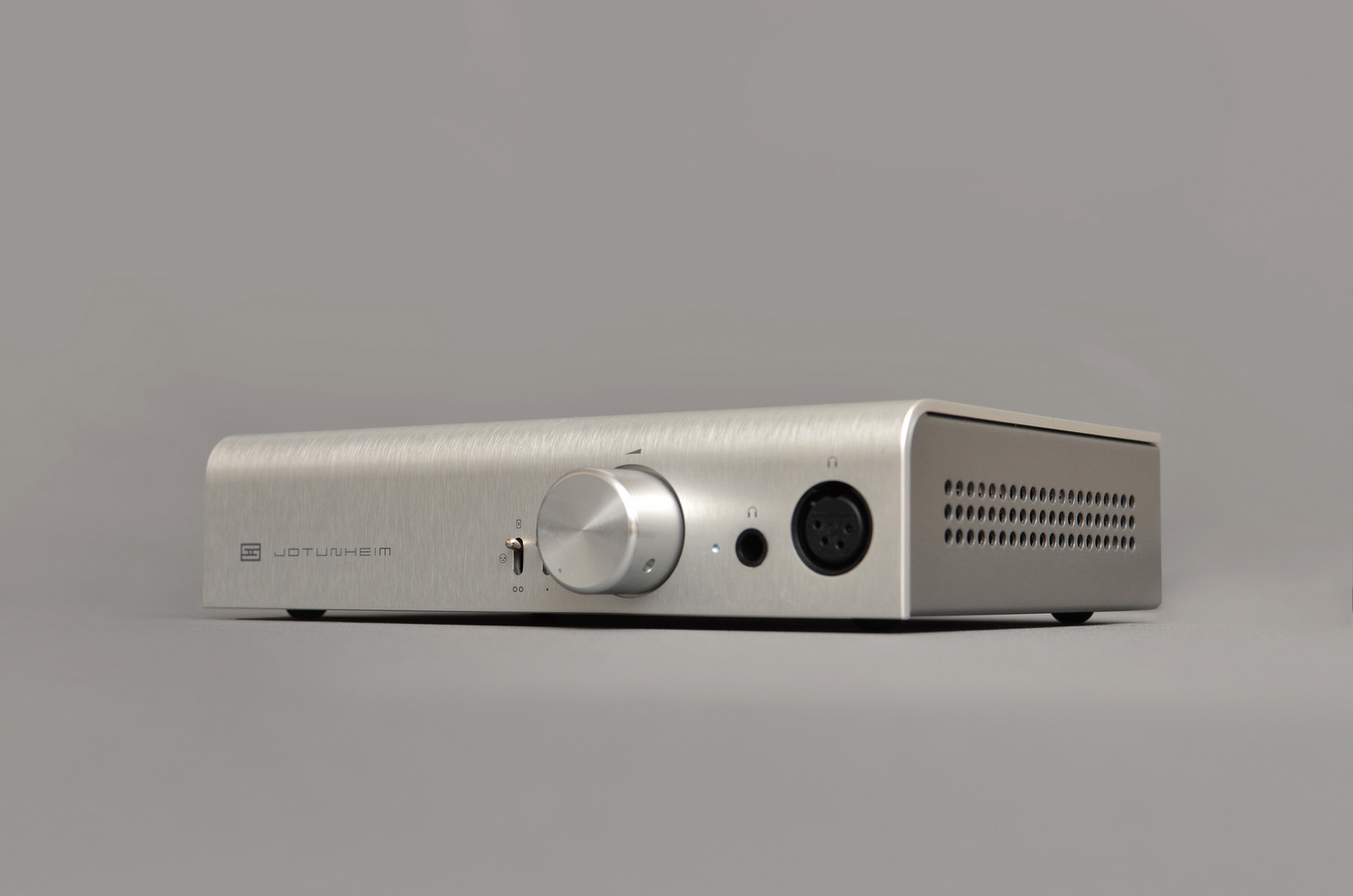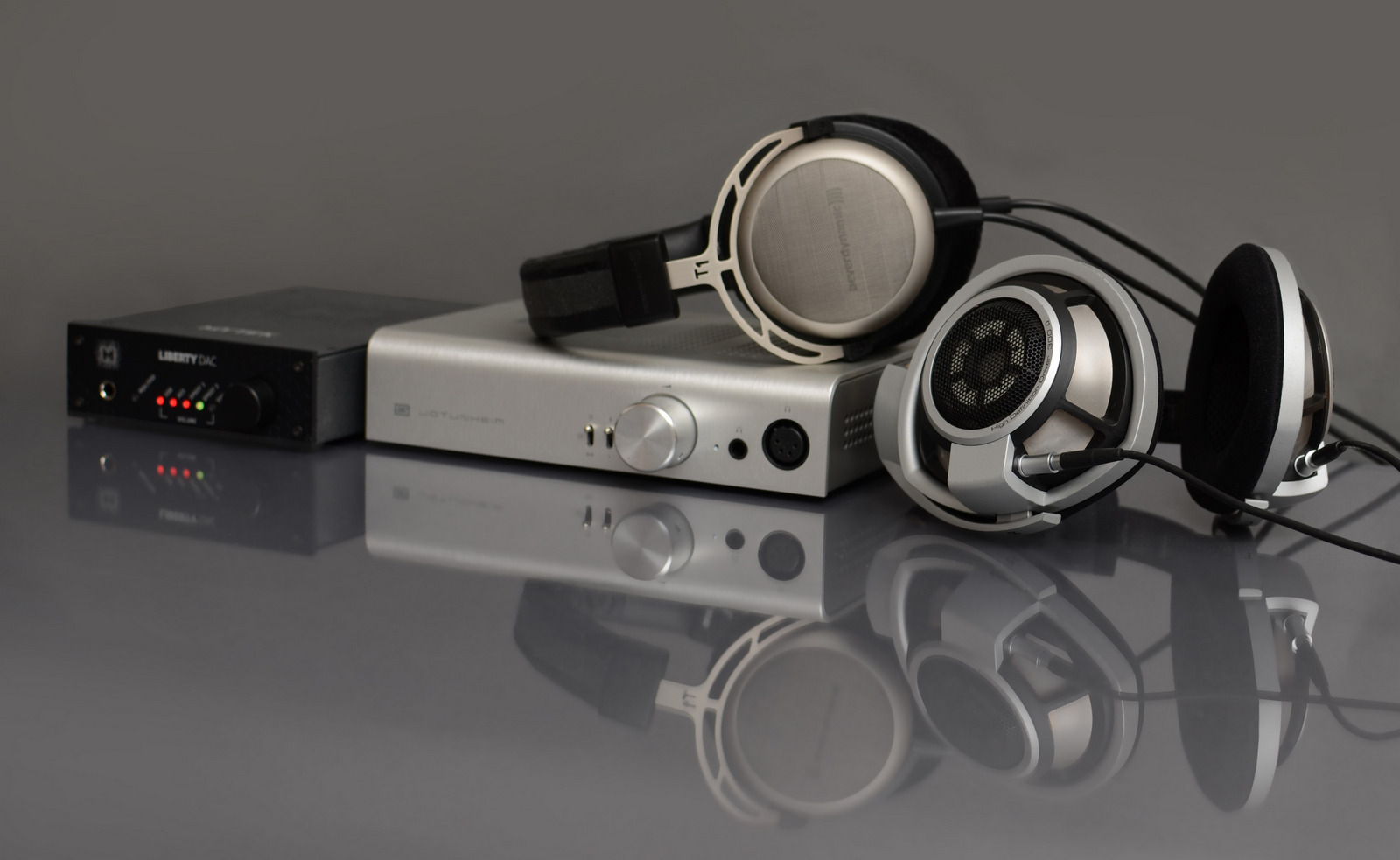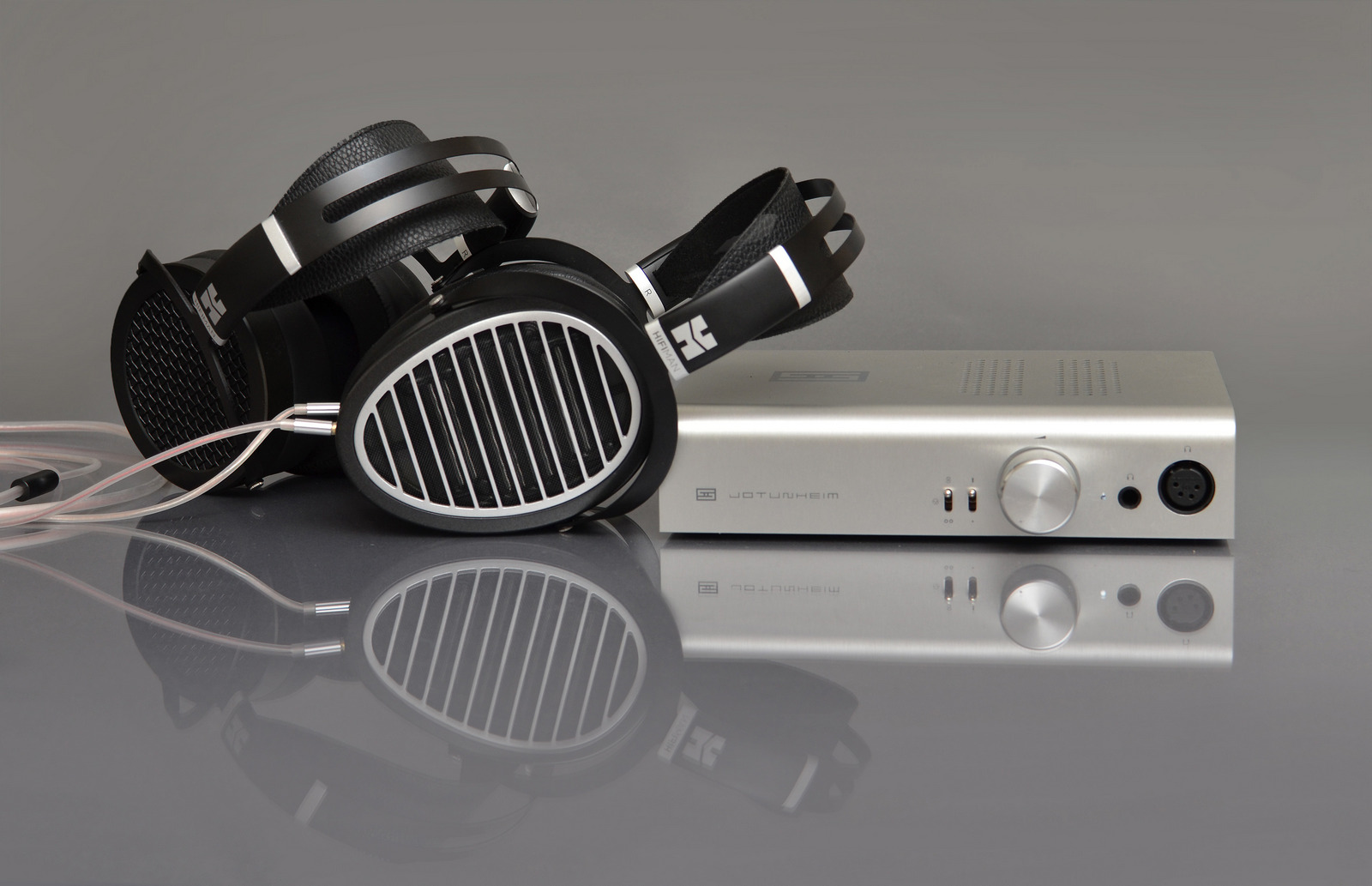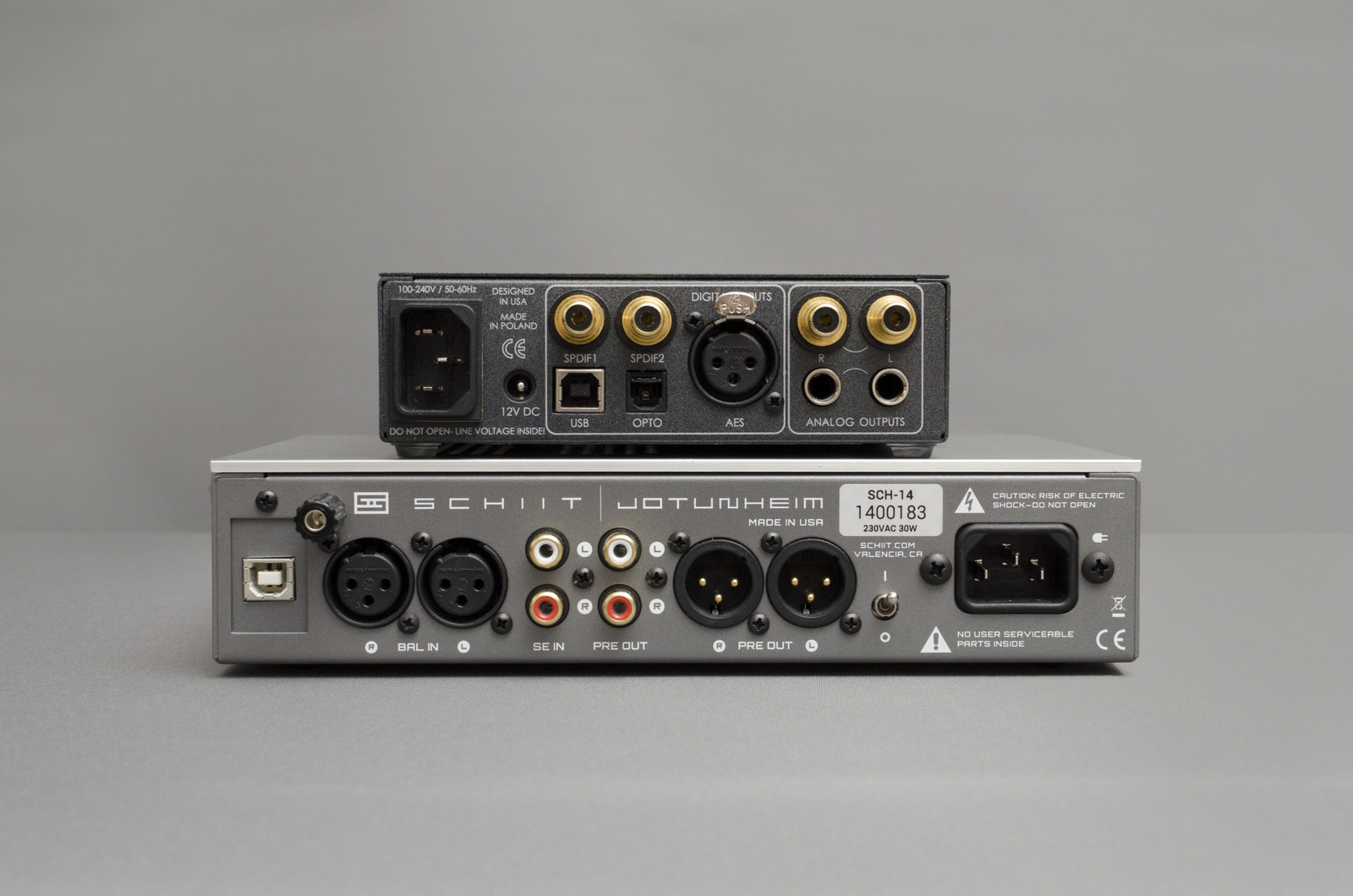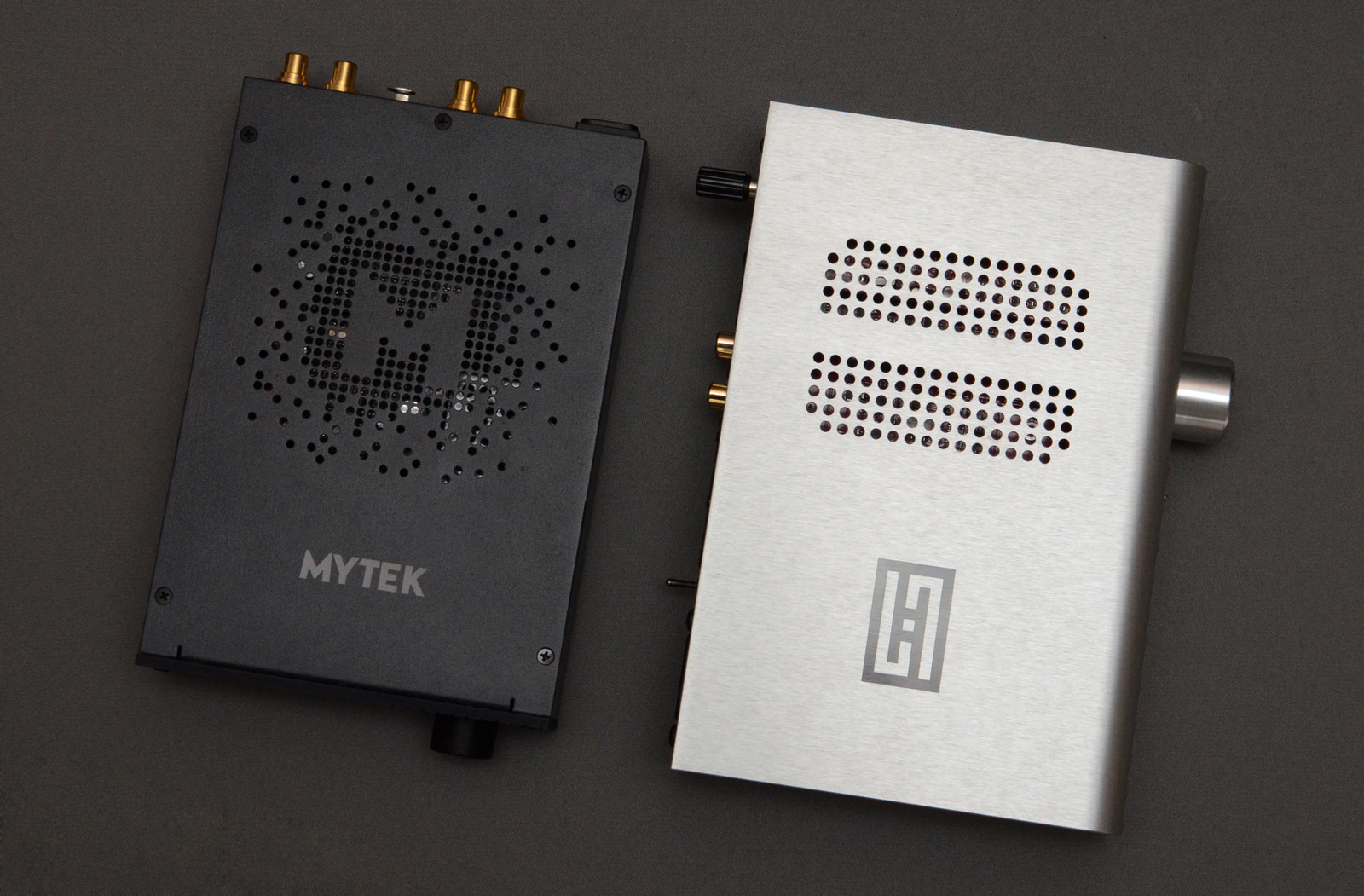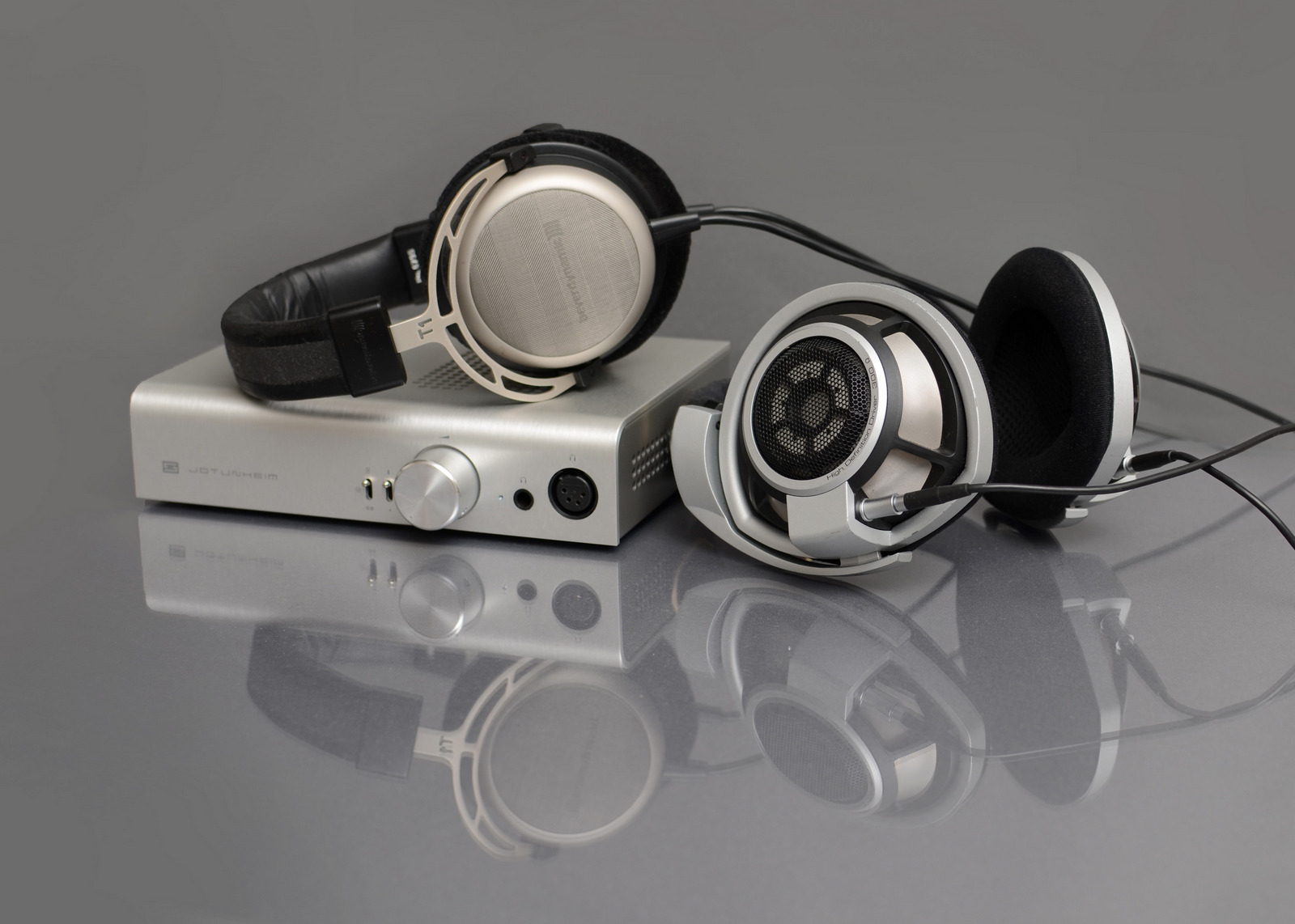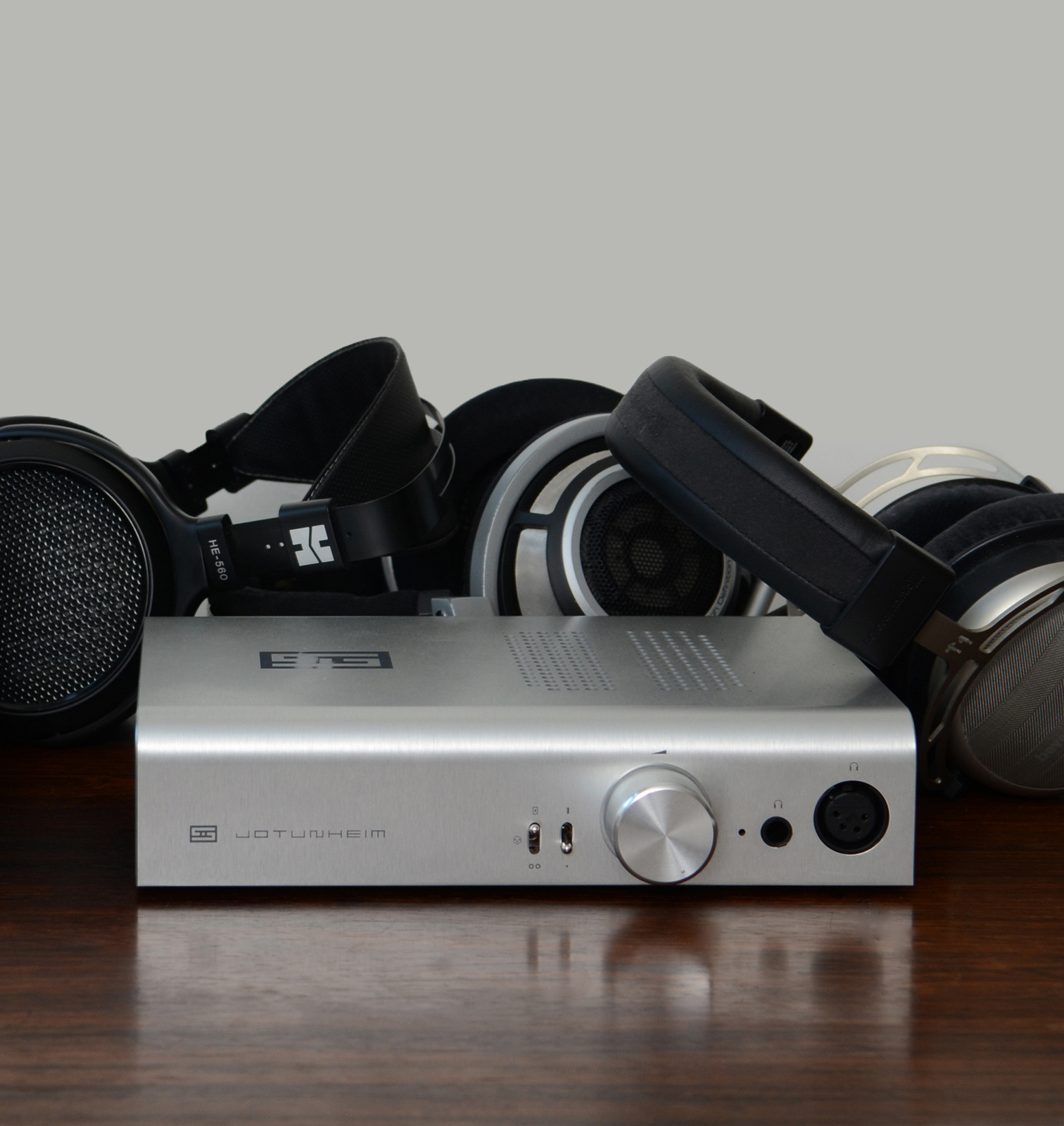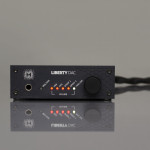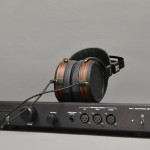The Schiit Jotunheim is named after the Norwegian mountain range Jotunheimen, which in turn is named after the Jotuns, which are god-like giants from Norse mythology. The name indicates power, and the Schiit Jotunheim is indeed a resourceful amplifier for its compact size.
The Jotunheim has an open slot which you can choose to fill with one of three options: A “Balanced” USB DAC, a “Multibit” USB DAC, or a passive phono stage. Schiit markets the Jotunheim slot as somewhat future proof: “In the future, you’ll be able to easily upgrade to a different module—maybe even something beyond a DAC or phono preamp”. The first thing I think when reading this is that a streamer module ala the Mytek Brooklyn Bridge would be terrific. Time will show.
There are both balanced and unbalanced analogue inputs, in addition to the optional DAC/phono card. Thus the Jotunheim can be quite flexible in many systems. On the output side there are balanced and unbalanced preamp outputs, and balanced and unbalanced headphone outputs.
The amp-only version is currently 399 USD, the version tested in this review has the most expensive “Multibit DAC” option, which makes the price in time of writing 599 USD.
Jotunheim Amplifier Comparison
First, let’s check out how the amplifier section of the Jotunheim sounds in comparison to some of the competition: The Violectric V200, the Beyer A20 and Schiit’s own Asgard 2.
Jotunheim vs Violectric V200
The V200 is almost three times the price of the Jotunheim, so I expected it to be an easy win for the Violectric. But why not start with a real challenge?
Denon AHD-7000 (unbalanced)
The classic Denon rocks big time with the Jotunheim. Kate Tempest´s “Europe is Lost” is really immersive. Moving over to the V200 opens it up a bit, but not that much. All through the playlist, the V200 is a bit better in most ways. There is a little more space and detail, but also a bit drier sound.
Hifiman Ananda
The Jotunheim is no slouch with the Ananda, but in direct comparison, the V200 clearly gets the upper hand. The bass is a lot tighter, the soundstage is more precise and deeper.
Audeze LCD-2 rev.1 (unbalanced)
The V200 is a bit clearer and spacious, the Schiit a bit warmer. I prefer the V200.
Focal Elear (unbalanced)
The V200 is more open, it is tighter, more spacious. With the Jotunheim there is less blackness between instruments, the bass is not as textured. The midrange is fuller, which in many ways is nicer. But the V200 defends its price tag.
Beyerdynamic DT1770PRO
Again, the Jotunheim is a nice performer, tuned a bit warmer than the V200, which comes out cleaner but somewhat less enveloping. The V200 has tighter bass and blacker background, but there is something about the Jotunheim – it feels a bit more rounded and enveloping.
Sennheiser HD660S
The Jotunheim is good with the 150 ohm HD660S but nonetheless the V200 is clearly the better amp. It is more open, resolved, tighter bass, better imaging.
Sennheiser HD800 (balanced and unbalanced)
Wow – this was a surprise. I like the HD800 with the V200 amplifier very much, and didn´t expect the Jotunheim to get close. But I find the difference between the two amps to be smaller with the HD800 than with the headphones I’ve tried so far. Maybe it is because the warmish sound signature plays well with the HD800. Maybe it is because, as I noted when comparing the Jotunheim to the Mytek Liberty DAC, the Jotunheim plays well with higher impedance cans. Anyhow, the HD800 is a treat on the Jotunheim, and moving over to the V200 does not improve the HD800 too much. The separation on the V200 is still better, but the overall presentation by the Jotunheim is very nice. I also like the treble better, it is less dry, more rounded – but it must be said I often find the HD800 too bright. Going back to unbalanced TRS on the Jotunheim still leaves the same impression. Very impressive Schiit.
Beyerdynamics T1 mk2
As with the 300 ohm HD800, the Jotunheim is great with the T1. I actually tend to prefer the Jotunheim. It is a bit fuller, the V200 a bit thin. This is a common problem with the T1, which is notoriously hard to match properly. There might be a tad more resolution with the V200, but the overall impression is certainly not to the disfavor of the Jotunheim. Great Schiit.
Sennheiser HD650
Another high impedance can that grows with proper amplification matching is the 300 ohm HD650. Not surprisingly, the Jotunheim performs great compared to the V200 also here. The is a little bit more openness from the V200, but overall, I must say I might even prefer the Jotunheim.
Audeze LCD-X (balanced)
In my last comparison, I go back to planars, an a very low impedance one. The V200 outperforms the Jotunheim by a quite clear margin, confirming my impression that the Jotunheim really punches above its weight with high impedance cans, not so much with planars.
Jotunheim vs Beyerdynamic A20
A small amp that is designed for high impedance cans in the Jotunheim price point is the Beyer A20.
Sennheiser HD650
The A20 is a step ahead with the HD650. The two amps are not too dissimilar, but the A20 has better control, with a similarly appealing sound signature.
Sennheiser HD800
With the HD800, the Jotunheim gets the upper hand, though. Not a big surprise, since I previously have tested the V200 vs the A20 and concluded that the V200 is better. After all, it is nice to feel some consistency when reviewing.
Beyerdynamics T1 mk2
Here it gets really close. They sound remarkably similar. Sometimes I think I might prefer the one over the other, but they are so close I really find it hard to pick a winner.
HD660S
They often sound quite similar, but with my male and female vocals test tracks, the Jotunheim pulls significantly ahead – the midrange seems to be a bit closed-in and compressed on the A20. With the Jotunheim, the voices opens up in a really nice way. Definitely a win to the Jotunheim.
Schiit Jotunheim vs Schiit Asgard 2
So, how does the bigger brother tackle the one of its smaller siblings?
Beyerdynamic T1
No competition. The Jotunheim is cleaner, fuller and warmer, with more niceness in every way.
Sennheiser HD800
The difference in sound signature is less apparent here, but the Jotunheim still clearly is the better choice. It is clearer, with more spaciousness. But they are not very dissimilar tonality/sound signature wise.
Sennheiser HD650
The gap narrows, but still, the Jotunheim is better, simply put clearer across the range.
Focal Elear
Again, I get a similar sound signature, but with better resolution from the Jotunheim. Listening to Leonard Cohen´s voice on the Asgard it feels a bit compressed and muddy, with the Jotunheim it opens up with more texture. With string music, the strings have more air, texture, timbre and lightness with the Jotunheim.
Hifiman Sundara
The Asgard 2 does quite well with the Sundara, which is quite hard to drive properly. The Jotunheim is still a tad better. It is cleaner and with a blacker background.
Sennheiser HD660S
As before, the two amps sound similar, except for the fact that the Jotunheim simply is more resolved.
Conclusion – amplifier comparisons
The Jotunheim fares well against the three amps here, especially considering the retail price. The V200 is tonally the most different of the four. Jotunheim and Asgard 2 are quite similarly tuned, and the Jotunheim and the A20 are not that different either.
The Jotunheim is a good all round performer, but really seem to excel above its price point with some of the higher impedance headphones in the test, especially HD800 and T1 mk2.
DAC/Amp Comparison Schiit Jotunheim Multibit vs Mytek Liberty
The Liberty DAC is first and foremost a DAC. But it has a very nice headphone output, so it is a relevant piece of gear to compare the Schiit Jotunheim with. At around 1000 USD, the Liberty is significantly more expensive. It has more digital inputs, but no analog input.
For this comparison I also hooked up the Auralic Taurus headphone amplifier for reference.
Hifiman HE560 (balanced cable)
The HE560 is not an easy headphone to drive well, but both DAC/Amps manage to give enough oomph to make it sound good. I run the HE560 from the balanced output of the Schiit, which does sound a bit better with the HE560 than the lower power unbalanced output.
The Jotunheim is markedly beefier in its presentation and does a good job, but the Liberty sharper cut, faster and more dynamic. Thus I prefer the Liberty, which fares surprisingly well compared even to the Taurus.
Hifiman Ananda (unbalanced cable)
The Jotunheim and Liberty are both great with the Ananda, and quite similar. With Tomaz Stanko´s “Terminal 7”, the cymbals are a bit crisper with the Liberty, there is a tiny bit more space around instruments, a bit more snappiness. But the difference is not big.
With the Modo Antiquo’’s strings in “The Young Vivaldi”, the Liberty is again crisper, the Schiit has a fuller, slightly less textured presentation. With “Marching Orders” by Led Bib, the bass is powerful with both, but the Liberty feels a tad tighter and cleaner all round. Playing Yazz Ahmed´s “Inspiration, Expiration”, the Liberty is slightly more open, but the rounder feeling of the Jotunheim is not bad either
Generally, the Schiit is good, but less snappy than the Liberty. Thus, I end up preferring the Liberty with the Ananda. I didn’t get to test the Ananda with the balanced output of the Jotunheim, but the Ananda is not a very heavy load, and since I prefered the HE-560 with the Liberty over the balanced Schiit, I suspect it wouldn’t make much of a difference.
Comparing them both to the Auralic Taurus, they both fall a bit short, the Taurus manages to be combining detail and snappiness with fullness.
Sundara (unbalanced cable)
Unfortunately, I do not have a balanced cable that works with the Sundara either (it has the same cable connectors as the Ananda), Sundara is harder to drive than the Ananda, and could potentially benefit from the higher power balanced output of the Jotunheim. But again, it didn´t shift the tables with the HE560.
The Liberty is better, with more separation, snap and detail. The Jotunheim feels a bit tame in direct comparison. Don´t get me wrong, the Jotunheim is not doing the Sundara injustice, but the Liberty would be my first pick.
Compared to the Taurus, however, the Liberty amp section falls a bit short.
AKG K701
All three amps are doing a good job. Not really much of a difference.
Shure SRH-1840
As with the K701, all are good, not much of a difference.
Sennheiser HD650
All three fares well but the Taurus is a tad better than the Jotunheim, the Jotunheim a tad better than the Liberty.
Audeze LCD-X
The Liberty is tighter and snappier, it feels more precise and dynamic. The Jotunheim (balanced) is great too, with a nice slightly meatier presentation, but not as good as the Liberty.
Compared to the Taurus, they both fall just a tad short. As before, it combines both strengths: It is as full bodied as the Jotunheim, as, precise and dynamic as the Liberty.
Sennheiser HD800
I really like the HD800 with the Jotunheim. It is a bit fatter and bolder compared to the Liberty, which gets a bit thin and sterile. The Liberty has plenty of detail and punch, just lacking a bit with regards to getting the right feel. There is something hyper-realistic about the Liberty which makes it a bit unnatural to my ears, and I much prefer the HD800.
The Taurus is significantly better than both, tough.
Audio Research AR-H1 (unbalanced)
Both do a great job with the AR-H1. The Jotunheim again is a tad fuller than the Liberty, which makes it a slight trade-off. The Taurus opens things up a bit more without losing the full-bodied niceness reminiscent of the Jotunheim.
Sennheiser HD700 (balanced)
The two DAC/Amps are quite close, but again, the Schiit is a tad fuller in a nice way. The Taurus is a bit better than both.
Beyerdynamic T1 mk2 (balanced)
Again, the Schiit is fuller and way nicer sounding, than the Liberty, which is detailed and snappy, but feels too thin and is not a good match for the 600 ohm T1. Nor is the Taurus, which although a bit better than the Liberty, in total to me isn’t any better than the warmer sounding Schiit – but there is a trade off between detail and warmth/fullness.
Fostex TH900 (unbalanced)
Both are good, but the Liberty is more dynamic and alive. I don’t really feel the Taurus is any better than the Liberty here, with the important exception of hiss: The TH900 is a very sensitive, low impedance headphone, and there is some unfortunate background hiss with the Liberty/TH900 which for some would be a dealbreaker.
Focal Elear (unbalanced)
Both are great, and immediately quite similar. The Jotunheim is a bit fatter sounding with SmashingscPumpkins “Rocket”, the bassy track “Edmond” by Prins Thomas is a bit more open sounding with the Liberty. The beautiful voice of jazz singer Solveig Slettahjell is a bit more textured with the Liberty.
Moving over to the Taurus I notice an improvement: A more open presentation, at the same time in a fuller and smoother way.
The Jotunheim Multibit DAC vs Liberty DAC
Here is how I found the Multibit DAC of the Jotunheim to compare to the Mytek LIberty DAC when connecting them both to external amplifiers:
Setup 1: Master 9 amp with HE1000mk2
After a couple of hours of a/b-ing I cannot say that the difference between these are huge. It is actually surprisingly often not easy to tell them apart. But when I do, the Mytek Liberty consistently is better resolved and tends to feel a bit more open, nuanced and relaxed. With the “Young Vivaldi” album by Ensemble Modo Antiquo, the Liberty has a gentler presentation, it feels smoother and has less edgy sounding strings. With “Pantha Du Prince” by The Bell Laboratory, the Liberty feels a bit clearer and more open.
Setup 2 Leben CS300XS with Ananda and Sundara
With the Hifiman Ananda, I tend to find the Liberty a tad clearer and more sparkling, but sometimes have to listen very hard to find the differences. Switching to the less resolving Hifiman Sundara headphone, I simply cannot tell them apart.
Concluding, the Multibit really holds up well, even against a great DAC as the Liberty. The Liberty is better, but you need quite a resolving setup to benefit much from that. The Jotunheim Multibit DAC takes you a really long way for the money.
Conclusion Jotunheim vs Liberty
I think the Jotunheim performs well across the board. But as I experienced when comparing the Jotunheim to other amplifiers, I really found it to excel the most with higher impedance cans. I am not saying it isn’t good with lower impedance headphones, it is just that it does not seem to stretch as much beyond its price tag. The Liberty is somewhat the other way around, it is at its best with planars where it often pulls ahead of the Schiit.
I never found the Jotunheim to be too thin or sharp sounding, but it is sometimes at the cost of clarity. The Liberty is the other way around, always clear and sharp, but sometimes too sharp. Another weak spot for the Liberty is a small audible hiss with sensitive headphones. I find the The Jotunheim is silent with all the headphones I have tested, also with the gain switch set to “high”. Even my Monk earbuds and Momentum Sennheiser headphones are silent with the Jotunheim.
Choosing between the two, the Liberty has a better DAC and a headphone amplifier section that is tighter and snappier with many headphones (mainly planars), but can get too sterile with the HD800 and T1. It also has a low level hiss issue with sensitive cans. The Jotunheim, on the other hand, does nothing wrong. It works with all headphones, and would be the safer choice.
Main Conclusion
There is a lot to like about the Jotunheim: It is versatile and powerful. It is flexible and capable. It handles every headphone I have tried well. It is not always the last word in clarity and fast dynamics, but considering the price and the versatility, it is hard to beat. The Multibit DAC is surprisingly good, and you need to really step up to get significant improvement.
This unit was kindly lent to The Headphoneer for the purpose of this review by Duet.no
MANUFACTURER SPECIFICATIONS
Amplifier:
Frequency Response: 20Hz-20Khz, -0.1db, 2Hz-700KHz, -3dB
Balanced Headphone Output:
Maximum Power, 16 ohms: 7500mW RMS per channel
Maximum Power, 32 ohms: 5000mW RMS per channel
Maximum Power, 50 ohms: 3000mW RMS per channel
Maximum Power, 300 ohms: 900mW RMS per channel
Maximum Power, 600 ohms: 500mW RMS per channel
Single-Ended Headphone Output:
Maximum Power, 16 ohms: 2500mW RMS per channel
Maximum Power, 32 ohms: 1500mW RMS per channel
Maximum Power, 50 ohms: 800mW RMS per channel
Maximum Power, 300 ohms: 350mW RMS per channel
Maximum Power, 600 ohms: 175mW RMS per channel
THD: <0.001%, 20Hz-20KHz, at 1V RMS
IMD: <0.0015%, CCIR SNR: >109db, A-weighted, referenced to 1V RMS
Crosstalk: >-70dB, 20 Hz-20KHz
Output Impedance: Less than 0.1 ohms, balanced or SE, at both gain settings
Input Impedance: 50K ohms
Gain: 2 (6dB) or 8 (18dB), selectable via front switch
Inputs: Balanced XLR and Single-Ended RCA, selectable via front switch
Outputs: Balanced headphone (4-pin XLR), single-ended headphone (1/4” TRS), balanced line preamp, single-ended line preamp
Optional Inputs: Multibit DAC, AK4490 DAC, or Passive MM Phono
Gain Stage: Proprietary Schiit Pivot Point™ fully discrete differential current-feedback topology
Power Supply: One 48VA transformer with 6 stages of discrete or integrated regulation and over 70,000uF total filter capacitance
Optional Dual AK4490 DAC:
USB Input Receiver: C-Media CM6631A
D/A Conversion IC: AK4490 x 2Input Capability: up to 24/192
Analog Output: fully differential, active summing and filtering
Frequency Response: 20Hz-20KHz, +/-0.1dB, 2-100kHz, -3dB
THD: <0.001%, 20Hz-20KHz, full scale
IMD: <0.001%, CCIR S/N: >108dB, referenced to 2V RMS, unweighted
Optional Multibit DAC:
USB Input Receiver: C-Media CM6631A
D/A Conversion IC: Analog Devices AD5547
Digital Filter: Schiit Comboburrito Time- and Frequency-domain Optimized DSP filter
Input Capability: up to 24/192
Analog Output: fully differential, active summing and filtering
Frequency Response: 20Hz-20KHz, +/-0.25dB, 2-100kHz, -3dB
THD: <0.005%, 20Hz-20KHz, full scale
IMD: <0.006%, CCIR S/N: >109dB, referenced to 2V RMS, unweighted
Optional Passive Filtered Phono Stage:
Gain: 42dB
THD: <0.01%, A-weighted, at 1V RMS SNR: >80dB, A-weighted, inputs shorted
Crosstalk: -70dB, 20-20kHz
Sensitivity: 2.3mV for 400mV output
Overload Margin: >20dB
Input Impedance: 47k ohms
Input Capacitance: 100pf
RIAA Accuracy: +/- 0.25dB, 20-20kHz
Topology: Fully passive RIAA network with AD8599 gain stages and PET film capacitors throughout, DC coupled, with DC servo
Power Consumption: 25W typical
Size: 9” x 6” x 2” (23 x 15 x 5 cm)
Weight: 6 lbs (2,7 kg)


